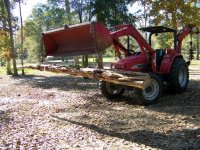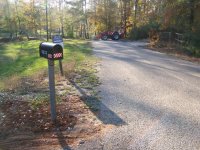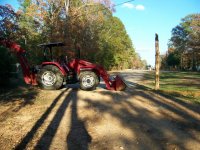bindian
Super Member
I finally started putting some fence posts up. This is one of the Mountain Juniper posts I cut down at Welding is Fun's place 2 years ago. I didn't pressure wash it, but took the bark off with a screwdriver. The outer stringy bark fell right off, but termites got under it and the smooth brown bark. This even with the posts a foot off the ground. The eastern red cedar post I had shed all it's bark by itself, but not these mountain junipers. The termites would not burrow past the white cedar, but you can see the trails them made on top of it.
I started the fence from the end of my driveway up to my new mailbox. The mailbox got flattened a few weeks ago and I replaced the wooden post with a 4 inch diameter, 1/4" thick galvanized pipe and augered a hole almost 5 feet deep and concreted it all in place. Let them flatten this mailbox and post! This fence will be 3 feet from the pavement that goes past the cul-de-sac and that will make it 12 foot from my property line, which runs down the middle of the pavement.
I topped the post at 10 feet, and plan on a 16 or 20 foot gate with a support wire from the top of this post.
hugs, Brandi



I started the fence from the end of my driveway up to my new mailbox. The mailbox got flattened a few weeks ago and I replaced the wooden post with a 4 inch diameter, 1/4" thick galvanized pipe and augered a hole almost 5 feet deep and concreted it all in place. Let them flatten this mailbox and post! This fence will be 3 feet from the pavement that goes past the cul-de-sac and that will make it 12 foot from my property line, which runs down the middle of the pavement.
I topped the post at 10 feet, and plan on a 16 or 20 foot gate with a support wire from the top of this post.
hugs, Brandi


